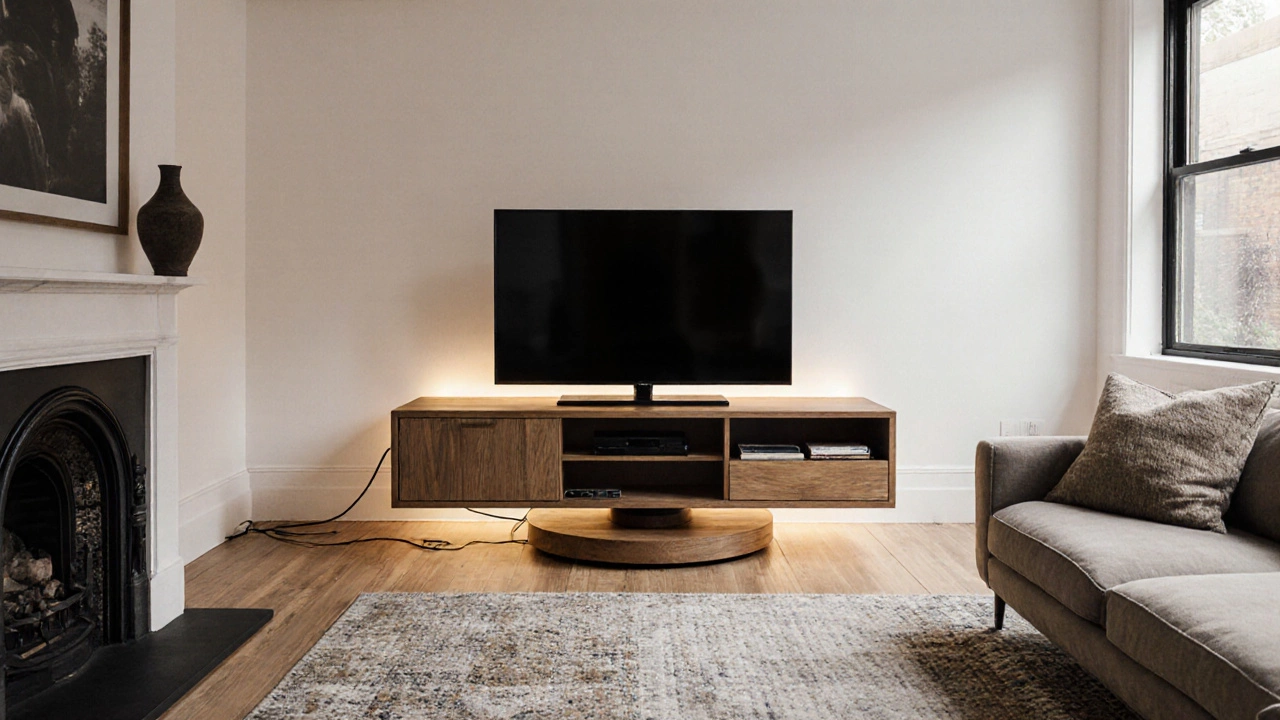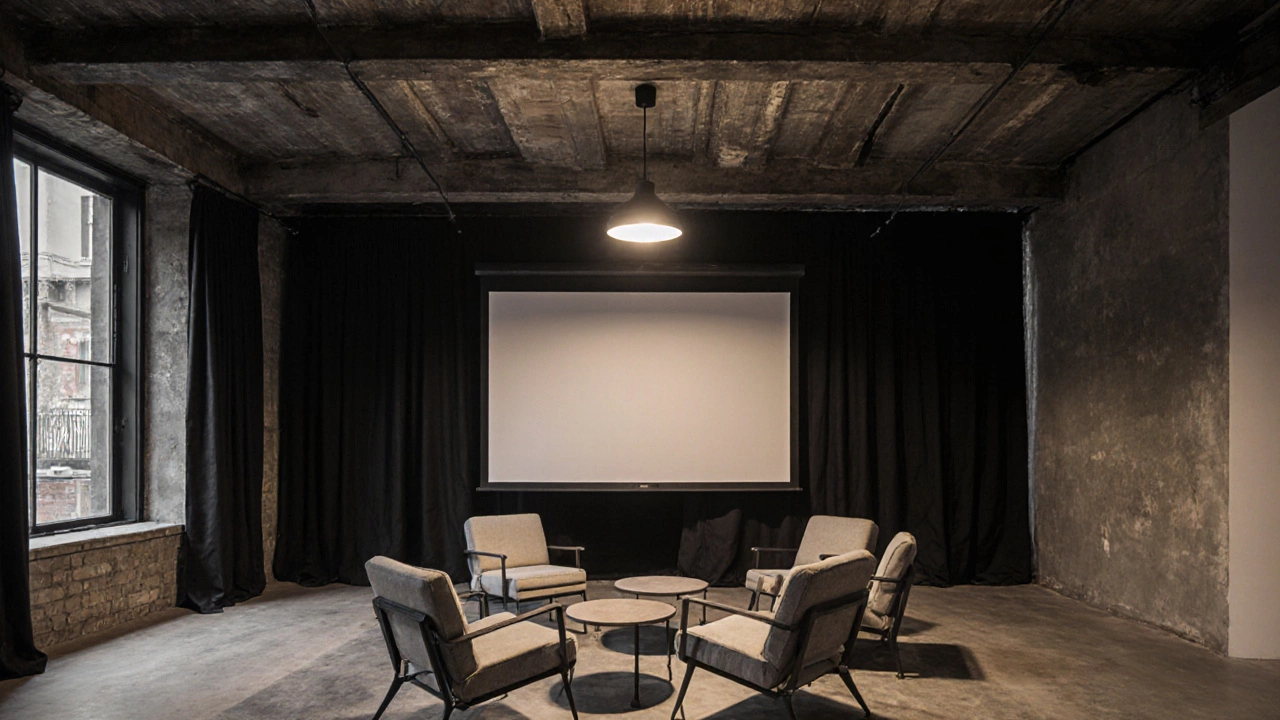TV Viewing Distance Calculator
Optimize Your Viewing Experience
The right TV size and placement makes watching comfortable and enjoyable. Follow these guidelines:
- Minimum viewing distance: 1.5 x TV size (inches)
- Ideal viewing distance: 2.0 x TV size (inches)
- Maximum viewing distance: 3.0 x TV size (inches)
You bought the perfect TV. You spent hours picking the right soundbar. But now it’s sitting on the coffee table, awkwardly angled toward the couch, or worse-stuck in a corner like an afterthought. If your living room doesn’t have a clear wall facing the main seating area, you’re not alone. Awkward layouts are common in older homes, open-plan spaces, or rooms with odd windows and doorways. The good news? You don’t need a renovation to fix this. Here’s how real people in Melbourne, Sydney, and beyond are solving this problem-without turning their living room into a home theater cave.
Stop forcing the TV against the main wall
Most design guides tell you to put the TV opposite the sofa. But what if that wall has a window? A fireplace? A sliding door? Forcing the TV there means glare, heat damage, or a view blocked by a screen. The biggest mistake people make is treating the TV like a painting that must hang on the ‘main’ wall. It’s not. It’s a functional device. Think of it like a lamp: you place it where the light is needed, not where the outlet is.Instead of fighting your room’s shape, work with it. Look at where people actually sit. Not where they’re supposed to sit. Where they end up when they’re watching Netflix in pajamas at 9 p.m. That’s your real focal point.
Mount it on a swivel arm
A swivel mount is the quiet hero of awkward living rooms. It costs less than $80 and changes everything. Install it on a side wall, near a window, or even next to a fireplace. Then angle the TV toward the main seating area. You can tilt it down to avoid glare from overhead lights or windows. People in sun-drenched homes in Brisbane and Perth swear by this. One client in Collingwood moved her TV from the narrow end of an L-shaped room to a side wall, added a 360-degree mount, and now she can watch from the kitchen nook, the couch, or even the armchair by the bookshelf.Pro tip: Get a full-motion mount, not just a tilting one. You want to be able to swing the TV left and right. Look for models rated for your TV’s weight. Check the VESA pattern on the back of your TV-it’s a 4-digit number like 400x400-and match it to the mount. Don’t skip the wall anchor inspection. Drywall alone won’t hold a 50-pound TV.
Use a media console with a turntable base
If you hate the look of wall mounts or your walls are concrete, try a media console with a rotating base. These aren’t just for showrooms-they’re practical. A 360-degree rotating stand lets you pivot the TV between two seating zones. One client in Fitzroy had a square living room with two seating areas: one facing the window, one facing the fireplace. The turntable console let the TV swing between both. No one had to move chairs. No one had to squint.Look for models with hidden cable management. You don’t want a mess of wires behind the TV. Some even have drawers for game consoles and streaming sticks. Avoid cheap particleboard ones-they warp over time. Solid wood or metal frames last longer. Brands like IKEA’s KUNGSBACKA or Sauder’s Corner TV Stand work well for under $300.

Hide it in a cabinet or closet
Not every TV needs to be visible. If your living room doubles as a reading nook or a formal space, consider hiding the TV. Install a cabinet with a motorized lift that lowers the screen when you press a button. Or use a sliding panel that covers the TV like a piece of art. When it’s off, it looks like a bookshelf or a mirror.This works best in homes where the TV isn’t the main focus. Think of it like a secret feature. You press a button, the screen rises. You’re done watching, it disappears. It’s expensive-$1,500 to $3,000-but if you have guests who hate seeing a TV in the living room, it’s worth it. Companies like Hideaway TV and Lutron make reliable systems. Even simpler: use a cabinet with doors and place the TV inside. Run the IR blaster to the front so the remote still works.
Place it on a narrow console beside the couch
Sometimes the best spot isn’t across the room-it’s right next to it. If your couch is pushed against a long wall with no clear opposite, try placing the TV on a slim console beside the end of the sofa. Angle it slightly inward. It’s not ideal for everyone, but it works if you only have one or two people watching. Add a small side table with a lamp to balance the visual weight.This setup is common in studio apartments and narrow townhouses. One Melbourne couple turned their 3-meter-wide living room into a cozy zone by putting a 55-inch TV on a 60cm-wide console beside their L-shaped couch. They sit at an angle, not head-on, but the screen is close enough that they don’t need a huge size. They use a soundbar with Dolby Atmos to fill the room. No mount needed. No wires hanging. Just clean, simple, and smart.
Go ceiling-mounted-yes, really
Ceiling mounts are rare, but they’re perfect for rooms with no good walls. Think: open-plan spaces with a central island, or rooms where the seating is arranged in a circle. A ceiling mount lets you hang the TV above the center of the room. Angle it down toward the main seating. It’s not for everyone-it looks like a projector-but it works in modern lofts and renovated warehouses.Use a low-profile mount that keeps the TV close to the ceiling. Avoid long arms that swing out too far-they look unstable. You’ll need a professional to install this. Make sure your ceiling joists can support the weight. And don’t forget: you’ll need a long HDMI cable or a wireless HDMI kit to avoid tripping over wires.

Use a projector instead
If your room is too weird for any TV setup, consider ditching the TV entirely. Projectors are cheaper than you think. A 1080p model with 2,500 lumens costs under $500. Pair it with a $150 retractable screen or even a plain white wall. You get a 100-inch screen without the bulk. You can roll it up when not in use. No glare. No mount. No wall space taken.Projectors need darkness. So if your living room gets bright sunlight, install blackout blinds. Or watch in the evening. Many people in Melbourne use projectors as their main TV because they love the big screen feel without the visual clutter. Brands like BenQ and Epson have models that auto-adjust for uneven surfaces. Some even have built-in Android TV.
What not to do
Don’t put the TV on the floor. It’s bad for your neck. Don’t mount it above the fireplace unless you’ve tested the heat. TVs over fireplaces often fail after a year. Don’t hide it behind glass doors-it creates reflections. And don’t buy a TV bigger than you need. A 65-inch screen in a small room feels like a billboard.Test your setup before you commit. Use cardboard cutouts to mark the screen size. Sit where you normally sit. Watch a movie for 20 minutes. If your neck hurts, move it. If you’re squinting, move it. If you’re constantly turning your head, move it.
Final tip: Make it feel intentional
The most successful TV placements don’t look like compromises. They look like design choices. Frame the TV with artwork on either side. Use matching side tables. Add a plant nearby. Put a rug under the seating zone to define the space. When the TV blends into the room instead of screaming for attention, it stops feeling like an intrusion.Your living room doesn’t need to be perfect. It just needs to work for you. The TV isn’t the star. You are.
Can I put my TV in the corner of the living room?
Yes, but only if you angle it properly. A corner mount with a swivel arm lets you turn the TV toward the main seating area. Don’t just stick it in the corner and expect people to turn their heads 45 degrees. That’s uncomfortable. Use a mount that allows at least 90 degrees of rotation. Also, make sure the TV isn’t too close to the wall-it needs airflow to cool down.
Is it bad to watch TV from the side?
Modern LED and OLED TVs have wide viewing angles, so watching from the side is fine. But you’ll lose some brightness and color accuracy compared to sitting directly in front. If you’re watching from a 45-degree angle, make sure your TV is no more than 8 feet away. For bigger rooms, use a larger screen. A 65-inch TV is better than a 50-inch if you’re off-center.
How high should the TV be mounted?
The center of the screen should be at eye level when you’re sitting. For most couches, that’s about 40 to 48 inches from the floor. If you’re mounting above a fireplace, add a tilting mount so you can angle it down. Never mount it higher than 60 inches unless you’re using a projector or have a very tall ceiling.
What if my living room has no walls free for a TV?
Then you have three options: use a ceiling mount, go with a projector, or place the TV on a console beside the couch. If you have a large open space, a projector on the ceiling works best. If you’re in a small apartment, a slim console with the TV angled toward the seating is the easiest fix. Avoid trying to hang it from the ceiling without support-drywall can’t hold it.
Should I avoid placing the TV opposite a window?
Yes, if possible. Sunlight creates glare that makes the screen unreadable. If you must place it there, use blackout curtains or a matte screen filter. You can also angle the TV slightly to avoid direct sunlight. Some people use ambient lighting behind the TV to reduce contrast. But the best solution is to move it to a different wall-even if it means using a swivel mount.


